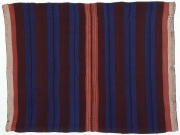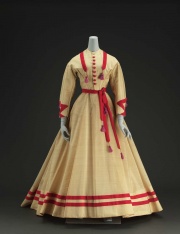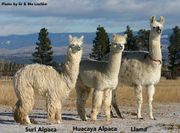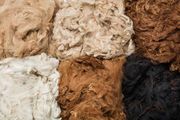Difference between revisions of "Alpaca"
| (12 intermediate revisions by 2 users not shown) | |||
| Line 1: | Line 1: | ||
| − | [[File:1992.573-E10137CR-d1.jpg|thumb|]] | + | [[File:1992.573-E10137CR-d1.jpg||thumb|Bolivian alpaca cloth]<br>MFA# 1992.573]] |
| + | [[File:52.1653-SC45598.jpg|thumb|thumb|Alpaca dress<br> MFA# 52.1653]] | ||
| + | [[File:Alpaca vs. llama 2 large.jpg|thumb|right|The two breeds of alpaca; Suri and Huacaya, standing next to a llama for comparison]] | ||
| + | [[File:AlpacaWool undyed colors (J.Lekavicius-Shutterstock).jpg|thumb|right|A few of the many colors of raw Alpaca wool]] | ||
== Description == | == Description == | ||
| − | |||
A silky wool obtained from a domesticated llama (''Lama pacos'', ''Vicugna pacos'') found mainly at high altitudes in Bolivia and Peru. Two breeds of alpaca, the huacaya and the suri, were developed in pre-Columbian times. The wool of the suri is fine and silky while the wool of the huacaya is shorter and slightly coarser. The straight, silk-like wool grows about 8 inches annually and will touch the ground if the animal is not sheared. Alpaca wool is lightweight, strong, lustrous, and can be white, light brown, or black. Because it is high in insulation value and resistant to rain and snow, alpaca is used in parkas, sleeping bags, and coat linings. The fibers are used alone or blended with [[cotton|cotton]], [[polyester%20fiber|polyester]], or sheep's [[wool|wool]] to make dress fabrics and suit fabrics. Imitation alpaca fabric is made of cotton, [[rayon%20fiber|rayon]], or [[acetate%20fiber|acetate]] yarns interwoven with a mohair filling. | A silky wool obtained from a domesticated llama (''Lama pacos'', ''Vicugna pacos'') found mainly at high altitudes in Bolivia and Peru. Two breeds of alpaca, the huacaya and the suri, were developed in pre-Columbian times. The wool of the suri is fine and silky while the wool of the huacaya is shorter and slightly coarser. The straight, silk-like wool grows about 8 inches annually and will touch the ground if the animal is not sheared. Alpaca wool is lightweight, strong, lustrous, and can be white, light brown, or black. Because it is high in insulation value and resistant to rain and snow, alpaca is used in parkas, sleeping bags, and coat linings. The fibers are used alone or blended with [[cotton|cotton]], [[polyester%20fiber|polyester]], or sheep's [[wool|wool]] to make dress fabrics and suit fabrics. Imitation alpaca fabric is made of cotton, [[rayon%20fiber|rayon]], or [[acetate%20fiber|acetate]] yarns interwoven with a mohair filling. | ||
| − | |||
| − | |||
== Synonyms and Related Terms == | == Synonyms and Related Terms == | ||
| Line 10: | Line 10: | ||
''Lama pacos''; ''Viguna pacos''; Alpaka (Deut., Pol.); alpaca (Esp., It., Ned., Port.); alpaga (Fr.); Luster (Ned); huacaya; suri; | ''Lama pacos''; ''Viguna pacos''; Alpaka (Deut., Pol.); alpaca (Esp., It., Ned., Port.); alpaga (Fr.); Luster (Ned); huacaya; suri; | ||
| − | == | + | == Physical and Chemical Properties == |
*Fiber length = 8 cm (undercoat) | *Fiber length = 8 cm (undercoat) | ||
| − | *Fiber diameter = | + | *Alpaca fiber comes in a range of diameters. Fiber quality is determined by the diameter of the fiber. Smaller fiber diameters are considered more luxurious and higher quality because they create softer wools. The following table has been adapted from the [http://aia.org.pe/la-alpaca/ International Alpaca Association]. |
| + | {| class="wikitable" | ||
| + | |- | ||
| + | ! Fiber Classification !! Avg.Fiber Diameter (microns) | ||
| + | |- | ||
| + | | Super Baby || ≤20 | ||
| + | |- | ||
| + | | Baby|| 20.1-23 | ||
| + | |- | ||
| + | | Fleece || 23.1-26.5 | ||
| + | |- | ||
| + | | Medium Fleece || 26.6-29 | ||
| + | |- | ||
| + | | Huarizo || 29.1-31.5 | ||
| + | |- | ||
| + | | Gruesa (Coarse) || >31.5 | ||
| + | |} | ||
| + | Alpaca fibers typically over 30 microns are often prickly to the skin. | ||
| + | |||
*IUCN Red List Status: Least Concern | *IUCN Red List Status: Least Concern | ||
*CITES Status: Unlisted; There are special regulations for the trade of Vicuna (''Vicugna vicugna'') and Guanacoe (''Lama guanacoe'') fibers and cloth, yet alpaca fibers and cloth are not listed. See [http://checklist.cites.org/#/en CITES] | *CITES Status: Unlisted; There are special regulations for the trade of Vicuna (''Vicugna vicugna'') and Guanacoe (''Lama guanacoe'') fibers and cloth, yet alpaca fibers and cloth are not listed. See [http://checklist.cites.org/#/en CITES] | ||
| Line 18: | Line 36: | ||
== Comparisons == | == Comparisons == | ||
| − | [[ | + | [[media:Properties of Natural Fibers.pdf|Properties of Natural Fibers]] |
== Additional Images == | == Additional Images == | ||
<gallery> | <gallery> | ||
| − | |||
File:26 alpaca 200X.jpg|Alpaca | File:26 alpaca 200X.jpg|Alpaca | ||
File:alpacanaturalcharcoallarge.jpg|Alpaca | File:alpacanaturalcharcoallarge.jpg|Alpaca | ||
</gallery> | </gallery> | ||
| + | ==Resources and Citations== | ||
| − | + | * ''Encyclopedia Britannica'', http://www.britannica.com Comment: alpaca" [Accessed May 8, 2003]. | |
| − | * '' | + | * Hoechst Celanese Corporation, ''Dictionary of Fiber & Textile Technology'' (older version called Man-made Fiber and Textile Dictionary, 1965), Hoechst Celanese Corporation, Charlotte NC, 1990 |
| − | * | + | * G.S.Brady, ''Materials Handbook'', McGraw-Hill Book Co., New York, 1971 Comment: p... 32 |
* J.Gordon Cook, ''Handbook of Textile Fibres:I Natural Fibres'', Merrow Publishing Co. , Durham, England, 1984 | * J.Gordon Cook, ''Handbook of Textile Fibres:I Natural Fibres'', Merrow Publishing Co. , Durham, England, 1984 | ||
| − | * | + | * Marjory L. Joseph, ''Introductory Textile Science'', Holt, Rinehart and Winston, Fort Worth, TX, 1986 |
| − | |||
| − | |||
| − | |||
| − | |||
* Rosalie Rosso King, ''Textile Identification, Conservation, and Preservation'', Noyes Publications, Park Ridge, NJ, 1985 | * Rosalie Rosso King, ''Textile Identification, Conservation, and Preservation'', Noyes Publications, Park Ridge, NJ, 1985 | ||
| − | |||
| − | |||
* Edward Reich, Carlton J. Siegler, ''Consumer Goods: How to Know and Use Them'', American Book Company, New York City, 1937 | * Edward Reich, Carlton J. Siegler, ''Consumer Goods: How to Know and Use Them'', American Book Company, New York City, 1937 | ||
| Line 51: | Line 63: | ||
* ''The American Heritage Dictionary'' or ''Encarta'', via Microsoft Bookshelf 98, Microsoft Corp., 1998 | * ''The American Heritage Dictionary'' or ''Encarta'', via Microsoft Bookshelf 98, Microsoft Corp., 1998 | ||
| − | * | + | * Wikipedia: http://en.wikipedia.org/wiki/Alpaca (Accessed Oct. 18, 2005), (Accessed Oct. 25, 2019) |
| − | |||
| − | |||
[[Category:Materials database]] | [[Category:Materials database]] | ||
Latest revision as of 14:12, 13 October 2020
Description
A silky wool obtained from a domesticated llama (Lama pacos, Vicugna pacos) found mainly at high altitudes in Bolivia and Peru. Two breeds of alpaca, the huacaya and the suri, were developed in pre-Columbian times. The wool of the suri is fine and silky while the wool of the huacaya is shorter and slightly coarser. The straight, silk-like wool grows about 8 inches annually and will touch the ground if the animal is not sheared. Alpaca wool is lightweight, strong, lustrous, and can be white, light brown, or black. Because it is high in insulation value and resistant to rain and snow, alpaca is used in parkas, sleeping bags, and coat linings. The fibers are used alone or blended with Cotton, polyester, or sheep's Wool to make dress fabrics and suit fabrics. Imitation alpaca fabric is made of cotton, rayon, or acetate yarns interwoven with a mohair filling.
Synonyms and Related Terms
Lama pacos; Viguna pacos; Alpaka (Deut., Pol.); alpaca (Esp., It., Ned., Port.); alpaga (Fr.); Luster (Ned); huacaya; suri;
Physical and Chemical Properties
- Fiber length = 8 cm (undercoat)
- Alpaca fiber comes in a range of diameters. Fiber quality is determined by the diameter of the fiber. Smaller fiber diameters are considered more luxurious and higher quality because they create softer wools. The following table has been adapted from the International Alpaca Association.
| Fiber Classification | Avg.Fiber Diameter (microns) |
|---|---|
| Super Baby | ≤20 |
| Baby | 20.1-23 |
| Fleece | 23.1-26.5 |
| Medium Fleece | 26.6-29 |
| Huarizo | 29.1-31.5 |
| Gruesa (Coarse) | >31.5 |
Alpaca fibers typically over 30 microns are often prickly to the skin.
- IUCN Red List Status: Least Concern
- CITES Status: Unlisted; There are special regulations for the trade of Vicuna (Vicugna vicugna) and Guanacoe (Lama guanacoe) fibers and cloth, yet alpaca fibers and cloth are not listed. See CITES
Comparisons
Additional Images
Resources and Citations
- Encyclopedia Britannica, http://www.britannica.com Comment: alpaca" [Accessed May 8, 2003].
- Hoechst Celanese Corporation, Dictionary of Fiber & Textile Technology (older version called Man-made Fiber and Textile Dictionary, 1965), Hoechst Celanese Corporation, Charlotte NC, 1990
- G.S.Brady, Materials Handbook, McGraw-Hill Book Co., New York, 1971 Comment: p... 32
- J.Gordon Cook, Handbook of Textile Fibres:I Natural Fibres, Merrow Publishing Co. , Durham, England, 1984
- Marjory L. Joseph, Introductory Textile Science, Holt, Rinehart and Winston, Fort Worth, TX, 1986
- Rosalie Rosso King, Textile Identification, Conservation, and Preservation, Noyes Publications, Park Ridge, NJ, 1985
- Edward Reich, Carlton J. Siegler, Consumer Goods: How to Know and Use Them, American Book Company, New York City, 1937
- The American Heritage Dictionary or Encarta, via Microsoft Bookshelf 98, Microsoft Corp., 1998
- Wikipedia: http://en.wikipedia.org/wiki/Alpaca (Accessed Oct. 18, 2005), (Accessed Oct. 25, 2019)





